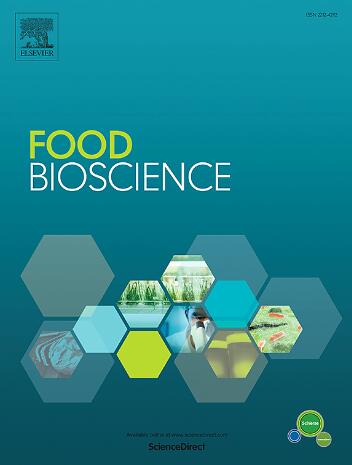Effect of high-intensity ultrasound on cowpea flours optimized by response surface methodology and the impact on their techno-functional properties
IF 4.8
1区 农林科学
Q1 FOOD SCIENCE & TECHNOLOGY
引用次数: 0
Abstract
High-intensity ultrasound (HIU) is a sustainable technology that modifies the techno-functional properties of foods, preserving their nutritional quality and aligning with current food trends. HIU was applied to a cowpea flour aqueous suspension (10 % w/v) to optimize the amplitude and time conditions through a response surface methodology, aiming to maximize the techno-functional properties of flours. Compositional, structural, morphological and thermal studies of two optimums C-US/87–15 (87 % amplitude/15 min HIU), C-US/39–52 (39 % amplitude/52 min HIU) and the untreated flour (NC) were carried out. HIU decreased the bulk density and increased the water and oil retention capacity, solubility and swelling power of the flour. HIU did not change the macronutrient content or in starch granule morphology; however, it significantly increased the amylose content due to the cleavage of α(1 → 6) bonds in the amylopectin branches, and increased the total dietary fiber (16.11 ± 0.04 g/100gflour to 18.3 ± 0.4 g/100gflour and 17.0 ± 0.4 g/100gflour), with the conversion of insoluble to soluble fiber. HIU unified the particle size (trimodal to bimodal distribution), increased the starch crystalline structures (FT-IR ratio 1022/995) and the peak viscosity from 1.7755 ± 0.0007 Pa.s to 1.90 ± 0.07 Pa.s and 1.91 ± 0.05 Pa.s. Gelatinization enthalpy reflected a greater molecular order, confirming the increase in crystalline structures as a result of HIU. This research demonstrates that HIU modifies the techno-functional properties of cowpea flour, expanding the possibilities for the production of plant-based foods using legume flours with better technological qualities with a gluten-free approach.

响应面法优化高强度超声对豇豆粉的影响及对其工艺功能特性的影响
高强度超声(HIU)是一种可持续的技术,可以改变食品的技术功能特性,保持其营养质量,并与当前的食品趋势保持一致。将HIU应用于豇豆粉水溶液悬浮液(10% w/v),通过响应面法优化振幅和时间条件,旨在最大限度地提高面粉的技术功能特性。对两种最佳材料C-US/87 - 15(87%振幅/15 min HIU)、C-US/39 - 52(39%振幅/52 min HIU)和未处理面粉(NC)进行了成分、结构、形态和热分析。HIU降低了面粉的容重,提高了面粉的保水、保油能力、溶解度和溶胀力。HIU没有改变淀粉颗粒的常量营养素含量和形态;然而,由于支链淀粉分支中α(1→6)键的断裂,使直链淀粉含量显著增加,膳食纤维总量从16.11±0.04 g/100gflour增加到18.3±0.4 g/100gflour和17.0±0.4 g/100gflour,不溶性纤维转化为可溶性纤维。HIU统一了淀粉的粒径(三峰分布到双峰分布),提高了淀粉的晶体结构(FT-IR比为1022/995),使淀粉的峰值粘度从1.7755±0.0007 Pa增加。s至1.90±0.07 Pa。1.91±0.05 Pa.s。糊化焓反映了更大的分子秩序,证实了由于HIU导致的晶体结构的增加。这项研究表明,HIU改变了豇豆粉的技术功能特性,扩大了用无谷蛋白方法生产技术质量更好的豆类粉生产植物性食品的可能性。
本文章由计算机程序翻译,如有差异,请以英文原文为准。
求助全文
约1分钟内获得全文
求助全文
来源期刊

Food Bioscience
Biochemistry, Genetics and Molecular Biology-Biochemistry
CiteScore
6.40
自引率
5.80%
发文量
671
审稿时长
27 days
期刊介绍:
Food Bioscience is a peer-reviewed journal that aims to provide a forum for recent developments in the field of bio-related food research. The journal focuses on both fundamental and applied research worldwide, with special attention to ethnic and cultural aspects of food bioresearch.
 求助内容:
求助内容: 应助结果提醒方式:
应助结果提醒方式:


